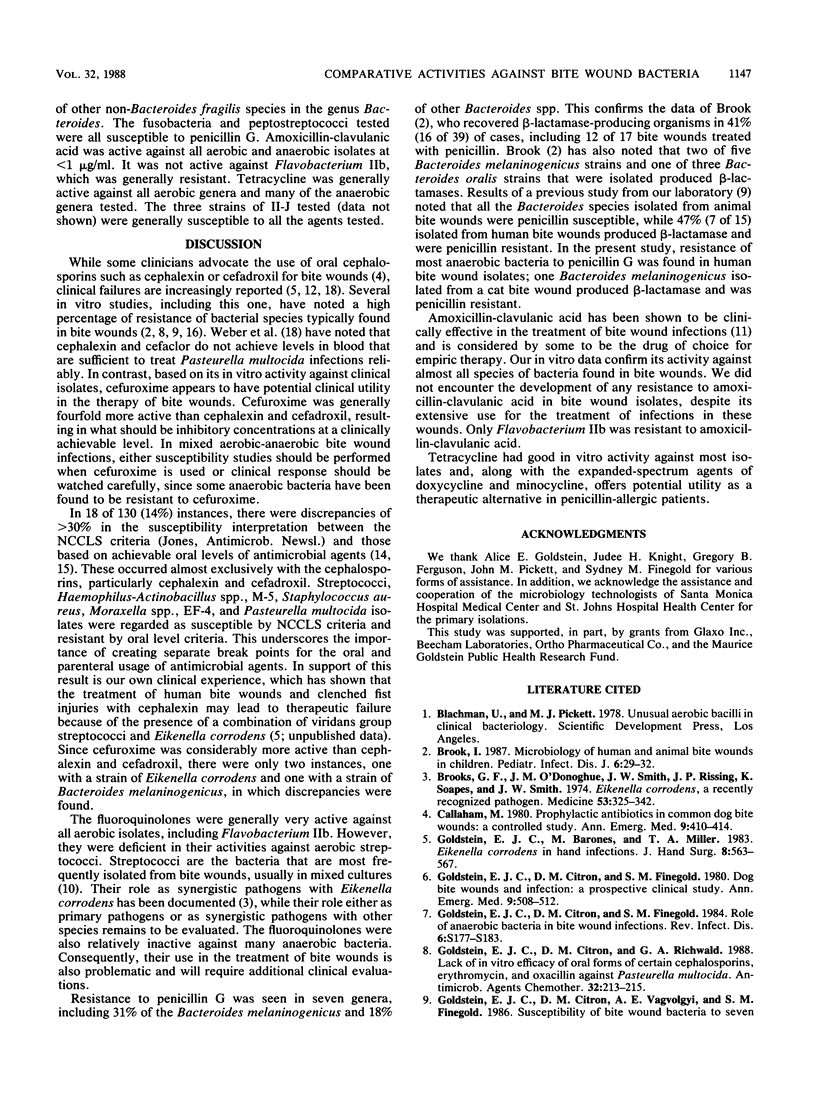Abstract
We studied the comparative in vitro activities of 10 oral antimicrobial agents against 147 aerobic and 61 anaerobic bacteria making up species in 13 genera (Staphylococcus aureus, streptococci, Eikenella corrodens, Pasteurella multocida, Haemophilus-Actinobacillus spp., M-5, EF-4, Moraxella spp., Flavobacterium IIb, Bacteroides melaninogenicus, Bacteroides spp., Fusobacterium spp., and Peptostreptococcus spp.) that were isolated from bite wounds. Cefuroxime was generally greater than fourfold more active than cephalexin and cefadroxil against all aerobic isolates, including Pasteurella multocida. The fluoroquinolones were highly active against most aerobic isolates but were less active against anaerobic isolates. Ciprofloxacin was generally more active than either enoxacin or ofloxacin. Discrepancies of greater than 30% in the interpretation of susceptibilities between break points suggested by the National Committee for Clinical Laboratory Standards and those related to oral dose peak levels (one-half to one-quarter of maximum achievable concentrations) were noted in 14% (18 of 130) of the instances.
Full text
PDF





Selected References
These references are in PubMed. This may not be the complete list of references from this article.
- Brook I. Microbiology of human and animal bite wounds in children. Pediatr Infect Dis J. 1987 Jan;6(1):29–32. doi: 10.1097/00006454-198701000-00008. [DOI] [PubMed] [Google Scholar]
- Brooks G. F., O'Donoghue J. M., Rissing J. P., Soapes K., Smith J. W. Eikenella corrodens, a recently recognized pathogen: infections in medical-surgical patients and in association with methylphenidate abuse. Medicine (Baltimore) 1974 Sep;53(5):325–342. [PubMed] [Google Scholar]
- Callaham M. Prophylactic antibiotics in common dog bite wounds: a controlled study. Ann Emerg Med. 1980 Aug;9(8):410–414. doi: 10.1016/s0196-0644(80)80153-3. [DOI] [PubMed] [Google Scholar]
- Goldstein E. J., Barones M. F., Miller T. A. Eikenella corrodens in hand infections. J Hand Surg Am. 1983 Sep;8(5 Pt 1):563–567. doi: 10.1016/s0363-5023(83)80126-9. [DOI] [PubMed] [Google Scholar]
- Goldstein E. J., Citron D. M., Finegold S. M. Dog bite wounds and infection: a prospective clinical study. Ann Emerg Med. 1980 Oct;9(10):508–512. doi: 10.1016/s0196-0644(80)80188-0. [DOI] [PubMed] [Google Scholar]
- Goldstein E. J., Citron D. M., Finegold S. M. Role of anaerobic bacteria in bite-wound infections. Rev Infect Dis. 1984 Mar-Apr;6 (Suppl 1):S177–S183. doi: 10.1093/clinids/6.supplement_1.s177. [DOI] [PubMed] [Google Scholar]
- Goldstein E. J., Citron D. M., Richwald G. A. Lack of in vitro efficacy of oral forms of certain cephalosporins, erythromycin, and oxacillin against Pasteurella multocida. Antimicrob Agents Chemother. 1988 Feb;32(2):213–215. doi: 10.1128/aac.32.2.213. [DOI] [PMC free article] [PubMed] [Google Scholar]
- Goldstein E. J., Citron D. M., Wield B., Blachman U., Sutter V. L., Miller T. A., Finegold S. M. Bacteriology of human and animal bite wounds. J Clin Microbiol. 1978 Dec;8(6):667–672. doi: 10.1128/jcm.8.6.667-672.1978. [DOI] [PMC free article] [PubMed] [Google Scholar]
- Goldstein E. J., Reinhardt J. F., Murray P. M., Finegold S. M. Outpatient therapy of bite wounds. Demographic data, bacteriology, and a prospective, randomized trial of amoxicillin/clavulanic acid versus penicillin +/- dicloxacillin. Int J Dermatol. 1987 Mar;26(2):123–127. doi: 10.1111/j.1365-4362.1987.tb00544.x. [DOI] [PubMed] [Google Scholar]
- Goldstein R. W., Goodhart G. L., Moore J. E. Pasteurella multocida infection after animal bites. N Engl J Med. 1986 Aug 14;315(7):460–460. [PubMed] [Google Scholar]
- Shikuma C. C., Overturf G. D. Antibiotic susceptibility of Pasteurella multocida. Eur J Clin Microbiol. 1985 Oct;4(5):518–519. doi: 10.1007/BF02014442. [DOI] [PubMed] [Google Scholar]
- Weber D. J., Wolfson J. S., Swartz M. N., Hooper D. C. Pasteurella multocida infections. Report of 34 cases and review of the literature. Medicine (Baltimore) 1984 May;63(3):133–154. [PubMed] [Google Scholar]


